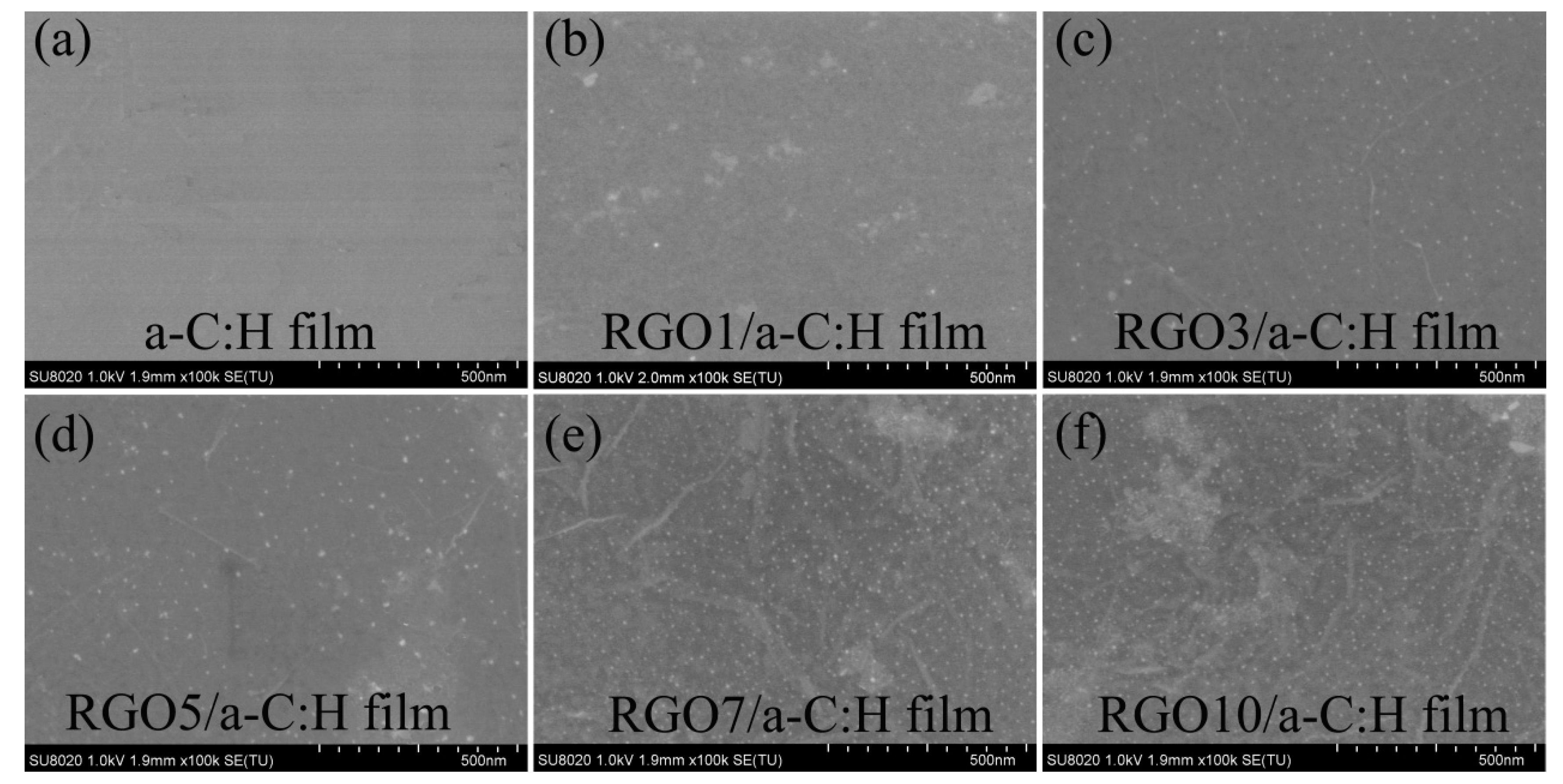Improving the Wear Life of a-C:H Film in High Vacuum by Self-Assembled Reduced Graphene Oxide Layers
Abstract
1. Introduction
2. Experimental Section
3. Results and Discussion
3.1. Raman and X-Ray Diffraction Characterization
3.2. SEM Morphological Examination
3.3. Tribological Performance
4. Conclusions
Author Contributions
Funding
Conflicts of Interest
References
- Andersson, J.; Erck, R.A.; Erdemir, A. Frictional behavior of diamond like carbon films in vacuum and under varying water vapor pressure. Surf. Coat. Technol. 2003, 163–164, 535–540. [Google Scholar] [CrossRef]
- Berman, D.; Erdemir, A.; Sumant, A.V. Few layer graphene to reduce wear and friction on sliding steel surfaces. Carbon 2013, 54, 454–459. [Google Scholar] [CrossRef]
- Song, H.; Ji, L.; Li, H.; Wang, J.; Liu, X.; Zhou, H.; Chen, J. Self-forming oriented layer slip and macroscale super-low friction of grapheme. Appl. Phys. Lett. 2017, 110, 073101. [Google Scholar] [CrossRef]
- Song, H.; Ji, L.; Li, H.; Liu, X.; Wang, W.; Zhou, H.; Chen, J. External-field-induced growth effect of an a-C:H film for manipulating its medium-range nanostructures and properties. ACS Appl. Mater. Interfaces 2016, 8, 6639–6645. [Google Scholar] [CrossRef] [PubMed]
- Qi, S.; Li, X.; Dong, H. Improving the macro-scale tribology of monolayer graphene oxide coating on stainless steel by a silane bonding layer. Mater. Lett. 2017, 209, 15–18. [Google Scholar] [CrossRef]
- Li, P.; Zhou, H.; Cheng, X. Investigation of a hydrothermal reduced graphene oxide nano coating on Ti substrate and its nano-tribological behavior. Surf. Coat. Technol. 2014, 254, 298–304. [Google Scholar] [CrossRef]
- Marcano, D.C.; Kosynkin, D.V.; Berlin, J.M.; Sinitskii, A.; Sun, Z.; Slesarev, A.; Alemany, L.B.; Lu, W.; Tour, J.M. Improved synthesis of graphene oxide. ACS Nano 2010, 4, 4806–4814. [Google Scholar] [CrossRef] [PubMed]
- Gupta, A.; Chen, G.; Joshi, P. Raman scattering from high-frequency phonons in supported n-graphene layer films. Nano Lett. 2006, 6, 2667–2673. [Google Scholar] [CrossRef] [PubMed]
- Mi, Y.; Wang, Z.; Liu, X. A simple and feasible in-situ reduction route for preparation of grapheme lubricant films applied to a variety of substrates. J. Mater. Chem. 2012, 22, 8036–8042. [Google Scholar] [CrossRef]




© 2019 by the authors. Licensee MDPI, Basel, Switzerland. This article is an open access article distributed under the terms and conditions of the Creative Commons Attribution (CC BY) license (http://creativecommons.org/licenses/by/4.0/).
Share and Cite
Song, H.; Chen, G.; Chen, J.; Li, H.; Ji, L.; Jiang, N. Improving the Wear Life of a-C:H Film in High Vacuum by Self-Assembled Reduced Graphene Oxide Layers. Nanomaterials 2019, 9, 1733. https://doi.org/10.3390/nano9121733
Song H, Chen G, Chen J, Li H, Ji L, Jiang N. Improving the Wear Life of a-C:H Film in High Vacuum by Self-Assembled Reduced Graphene Oxide Layers. Nanomaterials. 2019; 9(12):1733. https://doi.org/10.3390/nano9121733
Chicago/Turabian StyleSong, Hui, Gang Chen, Jie Chen, Hongxuan Li, Li Ji, and Nan Jiang. 2019. "Improving the Wear Life of a-C:H Film in High Vacuum by Self-Assembled Reduced Graphene Oxide Layers" Nanomaterials 9, no. 12: 1733. https://doi.org/10.3390/nano9121733
APA StyleSong, H., Chen, G., Chen, J., Li, H., Ji, L., & Jiang, N. (2019). Improving the Wear Life of a-C:H Film in High Vacuum by Self-Assembled Reduced Graphene Oxide Layers. Nanomaterials, 9(12), 1733. https://doi.org/10.3390/nano9121733



